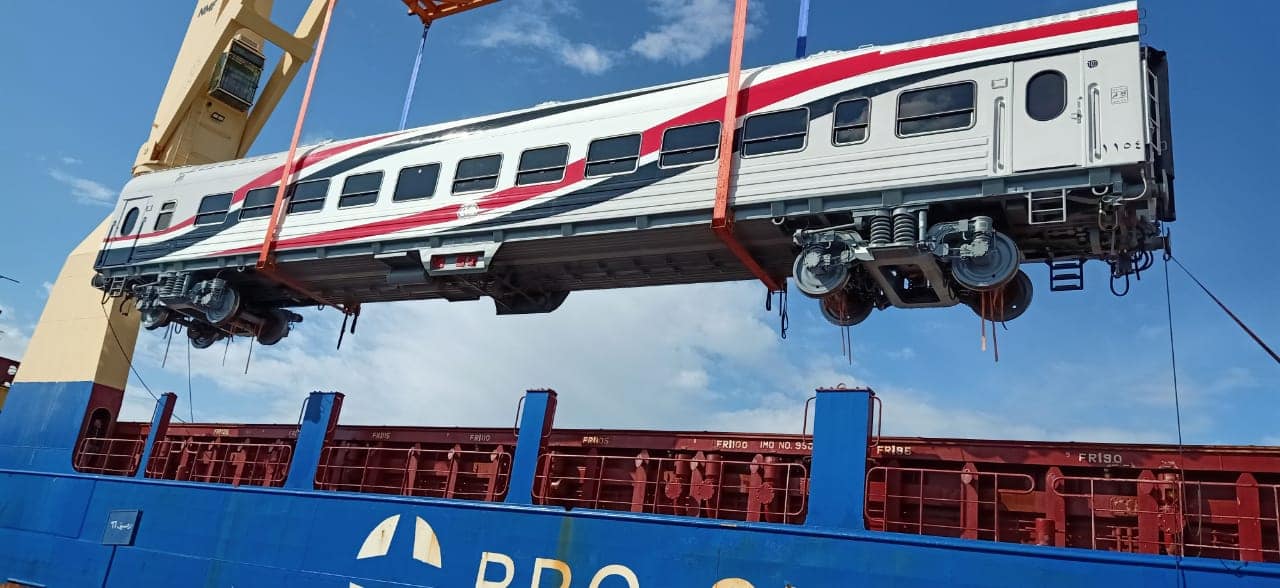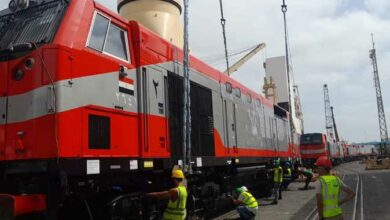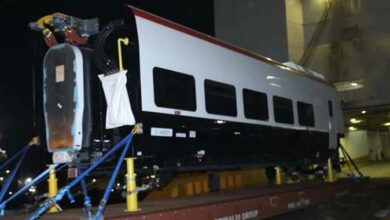
Through the dusty windows of the Bulaq al-Dakrur train station control tower, Karam Faheem, an inspector, pointed to a never-ending stream of people crossing the railway tracks below — through a railway repairs workshop.
“It’s impossible to stop them. When we try to close the workshop, they force their way in,” Faheem said.
As a train pulled into the station, Faheem’s colleague left the tower to hand the driver a piece of paper, handwritten permission for the train to proceed. Tower workers were being forced to use this method, Mohamed Badry said, because of a signaling failure between Bulaq and Imbaba since October of last year.
The short train ride from the Bulaq al-Dakrur station toward Cairo’s central Ramses Station — whose central ticket hall recently underwent a pharaonic-themed, LE170 million refurbishment — continues to tell of the malaises facing the railway system.
Train driver Gamal al-Sayed ran an obstacle course through ambulant dangers: people and animals crossing the tracks, and vehicles lingering at level crossings as the train bore down on them.
As he drove, Sayed pointed out railway land that has been appropriated by local residents, disused train tracks still vaguely visible underneath parked cars, horses and makeshift buildings.
The train passed the Ard al-Lewa crossing, the site of last week’s deadly accident, when an impatient taxi driver ignored the warning bell and collided with a train, killing himself and three passengers. Nothing has changed; traffic waited for the train to pass held back by a thin metal chain.
At the Negeely crossing, roughly five minutes down the line, crossing guard Mohamed al-Mosalemy did his best to control traffic as a ringing bell declared an oncoming train, armed only with a whistle.
Railway platforms often melt seamlessly into their surroundings in Egypt, the legacy of decades of informal construction alongside railway tracks, failure to erect and maintain barriers preventing usurpation of railway land, and dangerous trespassing on the tracks.
The resulting chaos on the railways has proven deadly, and, according to a World Bank paper, on average six fatalities are recorded for every 10 million trips — a rate that is at least six times above international best practices.
The accident tally makes for terrifying reading. In February 2002, a fire on a train packed to double capacity killed 373 people. The year 2006 witnessed two serious accidents. In August, two trains collided in Qalyub, killing 57 people. Eight days later, a passenger train collided with a freight train north of Cairo and five people died.
Last year, there were four serious accidents, including the Manfalout crossing collision in Assiut between a train and a school bus that took the lives of 48 children, the bus driver and their teacher.
This year began with a derailing that killed 19 Central Security Forces recruits on their way to Cairo for training.
A losing behemoth
The Egyptian National Railways (ENR) is a staggering behemoth that employs almost 70,000 people and transports some 1 million passengers on 1,300 daily services, making spectacular losses in the process. According to a 2005 Finance Ministry policy note produced as part of a public expenditure review, ENR’s operating loss in 2004 was LE1.404 billion.
The World Bank says that in the period between 2000 and 2007, ENR generated a cumulative deficit of LE6.53 billion, almost equivalent to its cumulative gross revenue of LE7.24 billion. Investment loans from Egypt’s National Investment Bank, Central Bank and foreign banks totaled about LE12 billion.
The Finance Ministry estimates that government transfers to cover operating deficits between 2000 and 2005 represented 0.10–0.50 percent of total public spending during that period.
“The financial deficit of ENR has a significant impact on the situation of public finances in Egypt. Under the present financial rules of the game, the railways sector is formally not subsidized by the government. But this situation is fictitious. ENR cannot finance its operational deficit and cannot pay off its investment loans,” the policy note says.
Meanwhile, the bulk of ENR’s losses are institutional in nature and mean that ENR simply doesn’t make enough money to cover its operating costs. Passenger traffic constitutes more than 90 percent of its traffic volume — compared with 68 percent in Britain — and is divided into four types of service: intercity, express, local and suburban.
The air-conditioned intercity service generates about 50 percent of passenger traffic revenue and is profit-generating. The other three services provide an important service for low-income groups, but all make a loss and face tough competition from private minibus services that are more expensive but quicker and sometimes more comfortable.
Subsidized fares to students and the military alongside low-traffic services to rural areas cost ENR more than LE1 billion annually, the World Bank says.
A World Bank project appraisal paper states that freight traffic, meanwhile, constituted only 6 percent of ENR’s total traffic volume, but provided 18 percent of its revenues in 2007.
Restructuring attempts
The government began a restructuring plan in 2006 based on World Bank policy recommendations. A 2006 amendment to the law that created ENR in 1980 allowed it to grant public utilities contracts to investors.
Gamal Eilesh, a jocular railways union man, described the outsourcing as a “great idea in theory,” but said that in practice it fell victim to the endemic corruption and cronyism in Egypt.
“Instead of money leaking out of one hole, it now leaks out of 20,” Eilesh said.
Individuals with no knowledge of the railways were brought in to head these autonomous companies, Eilesh alleged, describing a familiar scene of retired generals in chauffeur-driven cars presiding over “worn-down railway workers on three-piaster salaries whose situation didn’t change one bit.”
The restructuring created 1,444 new positions. Former ENR Vice President for Infrastructure Nabil Youssef said the absence of individuals qualified for these positions meant that the wrong people took them.
Eight subsidiary companies were formed as part of these reforms dealing with wagon and locomotive maintenance, cleaning, real estate management and information technology, among other functions. There have been allegations of corruption against some of these companies.
In 2010, for example, the Public Funds Prosecution ordered an investigation by the Illicit Gains Authority into a spare parts deal by the Egyptian Railways Maintenance and Services Company that was LE121 million higher than similar deals made in previous years.
Meanwhile, in 2009, the World Bank agreed on a US$270 million loan* to the government for an ENR restructuring project, later bumped up with an additional $330 million. The project includes modernization of signaling, centralized control systems, track renewal, and modernization of management and operating practices. In its project paper, the World Bank said the additional financing “will support ENR efforts to improve railway safety which remains a major challenge.”
“Poor signaling and infrastructure systems and outdated operational practices which heavily rely on human judgment and interference continue to hinder the safety of railways operations. Human error remains the most common cause of accidents,” the paper reads.
ENR will need to invest about LE19.7 billion in infrastructure, rolling stock and maintenance workshops over the next 10 years, the World Bank said, suggesting the development of freight services, fare restructuring and development of ERJET, the ENR subsidiary company responsible for managing real estate assets as possible sources of revenue.
Olivier Le Ber, lead transport specialist in the World Bank Middle East and North Africa Sustainable Development Department, told Egypt Independent that an Italian company, Salcef, is carrying out the work that began in October, with supervision from German firm DB International. Salcef has also constructed a factory in Egypt to produce concrete railway sleepers. A French company, Siestra, will supervise the signaling work, which has not yet begun.
But modernizing crossings isn’t a component of the railways restructuring plan. When asked about this, Le Ber said an automated barrier is “not a panacea,” and emphasized that traffic safety as a whole on the road is a big concern in many countries, including Egypt.
"[You need] an education campaign, but also better enforcement from the traffic police and better technical control of the car to make sure the car is road worthy, and also you have many aspects. It's not just the education component," Le Ber said.
He added, however, that the World Bank will raise the issue with the government during the next meeting.
Boulos Salama, a Cairo University professor of transport planning and railways who has investigated the causes of railway accidents in Egypt since 1974, said modernizing a crossing costs LE2 million to LE3 million, making it a costly venture.
There are barely enough funds to cover the acquisition of spare parts, Salama said. Indeed, the situation is so dire that, Eilesh said, Egyptian Railways Maintenance and Services Company technicians replace broken spare parts on locomotives by taking them from other locomotives. Both Eilesh and Badry warn that locomotive brake parts have been lacking for months.
Waiting for modernization
At the control tower next to the Negeely crossing, tower employee Ahmed al-Sayed proudly showed Egypt Independent the neatly wallpapered control room. He explained that he and his colleagues had paid out of their own pockets to decorate the workspace. “Why? Because I spend more time here than I do at home,” he said.
Control tower workers expressed frustration at the official response to accidents which, more often than not, ends at criminal prosecution of a junior ENR employee — such as a control tower worker — and grand promises of investment and reform by a senior official that rarely see the light of day.
Badry said safer conditions are more important for ENR staff than they are for the public, because when accidents happen, they are “scapegoats.”
“I’m happy to work for the railways. I love my job and I love the railways, but I go to work to feed my children, not to go to prison,” Badry said.
*Correction: A previous version of this article incorrectly stated the amount of the World Bank loan for the ENR restructuring project in pounds. The correct amount is in dollars. Due to an editing error, it also incorrectly referred to the train driver as the train conductor.




